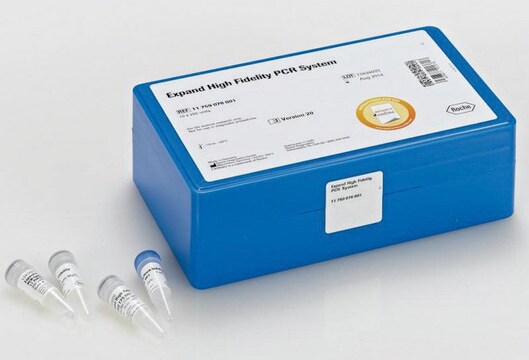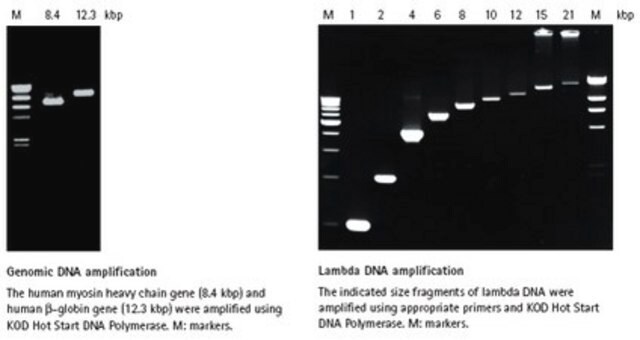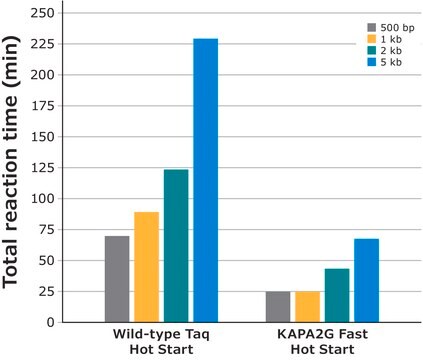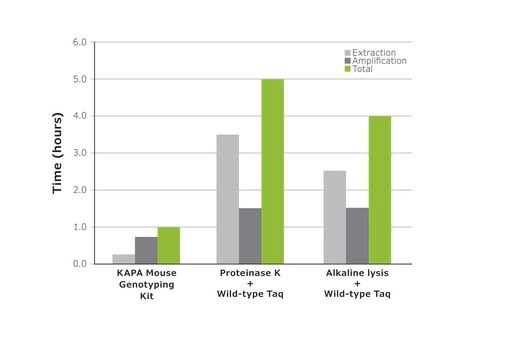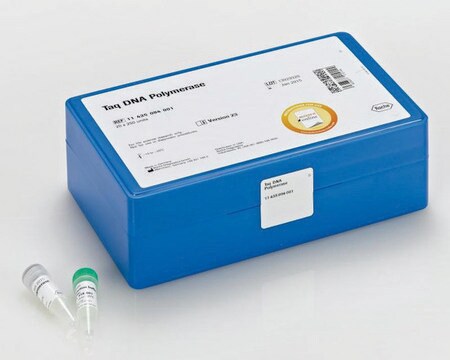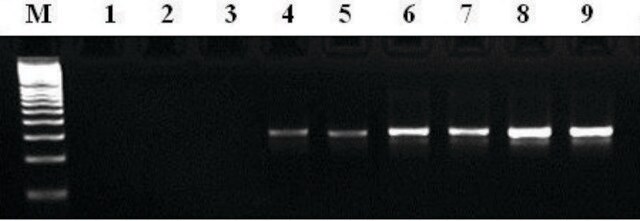PWOPOL-RO
Roche
Pwo DNA Polymerase
Synonyme(s) :
polymerase, dna, pwo
About This Item
Produits recommandés
Source biologique
microbial (Pyrococcus woesei)
Niveau de qualité
Forme
liquid
Utilisation
sufficient for ≤200 reactions (11644955001)
sufficient for 200 reactions
sufficient for ≤40 reactions (11644947001)
sufficient for 40 reactions
Activité spécifique
≥5000 U/mL
Poids mol.
90 kDa
Caractéristiques
High Fidelity PCR
dNTPs included: no
hotstart: no
Conditionnement
pkg of 100 U (11644947001)
pkg of 500 U (11644955001 [2 x 250 U])
Fabricant/nom de marque
Roche
Conditions de stockage
(Containers which are opened must be carefully resealed and
kept upright to prevent leakage)
Concentration
2.5 units/reaction
Technique(s)
PCR: suitable
Couleur
colorless
Entrée
purified DNA
Solubilité
water: soluble
Adéquation
suitable for enzyme test
Application(s)
genomic analysis
life science and biopharma
Activité étrangère
Endonucleases with lambda-DNA 30 units, none detected
Nicking act using pBR322-DNA ≤30 units, none detected
Température de stockage
−20°C
Catégories apparentées
Description générale
The use of Pwo DNA Polymerase during PCR significantly reduces the occurrence of random amplification errors.
Application
- Due to its proofreading activity, the thermostable Pwo DNA Polymerase has an extremely low error rate, 18-fold lower compared to Taq DNA Polymerase. It is therefore ideal for applications that require the highest possible fidelity in DNA synthesis. It can be applied for High fidelity PCR
- Cloning of PCR products
- Characterization of rare mutations
- PCR
Caractéristiques et avantages
- Excellent accuracy (18-fold more accurate than Taq DNA polymerase)
- High thermal stability
- Nearly as processive as Taq DNA polymerase
- Accepts modified nucleotides
Conditionnement
Qualité
- Activity: The enzyme is tested on activated DNA.
- Function: The enzyme is tested in two PCRs, using λDNA and human genomic DNA as templates.
- Proofreading ability: Proofreading activity is assayed according to the laq Iq fidelity assay [Frey, B. & Suppmann, B. (1995) Biochemica 2. 8-9].
- Absence of nucleases: The enzyme is tested on various substrates to ensure the absence of detectable endonucleases, exonucleases, and nicking activity according to the current Quality Control procedures.
Définition de l'unité
Unit Assay: Incubation buffer for assay on activated DNA
20 mM Tris-HCl, pH 8.8 (20 °C), 50 mM KCl, 2.5 mM MgCl2, 10 mM 2-mercaptoethanol, 0.2 mM of each dATP, dCTP, dGTP, dTTP.
Incubation procedure
12.5 mg activated calf thymus DNA and 0.1 mCi [α-32P]dCTP are incubated with 0.01 to 0.1 U Pwo DNA Polymerase in 50 μl incubation buffer with a paraffin oil overlay at +70 °C for 30 minutes. The amount of incorporated dNTPs is determined by trichloroacetic acid precipitation followed by scintillation counting.
Volume Activity: 5 U/μl
Notes préparatoires
Modified nucleotides are substrates
Pwo DNA Polymerase accepts modified nucleotides like digoxigenin-dUTP, biotin-dUTP, or fluorescein-dUTP. Thus, it can add these nucleotides to DNA during PCR. These nonradioactively labeled products can be used as a hybridization probe in many applications.
Magnesium concentration
If you use the magnesium-containing reaction buffer supplied with the enzyme, the final MgCl2 concentration in the PCR will be 2.0mM. For other magnesium concentrations (e.g., for optimizing the reaction to accommodate a particular template), use the magnesium-free reaction buffer and add appropriate amounts of the magnesium stock.
Autres remarques
Informations légales
Composants de kit seuls
- Enzyme is supplied in storage and dilution buffer
- PCR buffer, with 20 mM MgSO4 10x concentrated
- PCR buffer, without MgSO4 10x concentrated
- MgSO4 stock solution
Mentions de danger
Conseils de prudence
Classification des risques
Aquatic Chronic 3
Code de la classe de stockage
12 - Non Combustible Liquids
Classe de danger pour l'eau (WGK)
WGK 2
Point d'éclair (°F)
does not flash
Point d'éclair (°C)
does not flash
Certificats d'analyse (COA)
Recherchez un Certificats d'analyse (COA) en saisissant le numéro de lot du produit. Les numéros de lot figurent sur l'étiquette du produit après les mots "Lot" ou "Batch".
Déjà en possession de ce produit ?
Retrouvez la documentation relative aux produits que vous avez récemment achetés dans la Bibliothèque de documents.
Les clients ont également consulté
Notre équipe de scientifiques dispose d'une expérience dans tous les secteurs de la recherche, notamment en sciences de la vie, science des matériaux, synthèse chimique, chromatographie, analyse et dans de nombreux autres domaines..
Contacter notre Service technique

